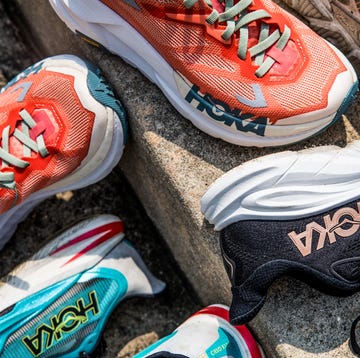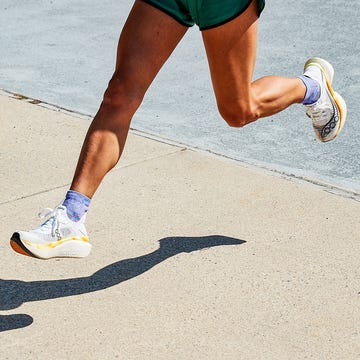Suppose we want to build the most comfortable long-distance running shoe imaginable. We’d start with a broad, foot-shaped toebox. That would give us enough wiggle room for foot swelling over double-digit miles, and a generous buffer against blisters and black toe nails. Plus, the ample space upfront lets our toes splay out, which can help disperse and soften the impact pressures associated with stress-related injuries.
But hold on—let’s say we also want this long-distance dream shoe to be fast.
Well, then we’ll have to rework that toebox.
Logic suggests that a wide design à la Altra and Topo Athletic could allow a runner to better engage their toes and forefoot during toe-off, which might help them generate more power and thus increase their running speed. But things become a bit more complicated when we add a carbon-fiber plate to the mix.
The carbon-fiber plate’s main role is to leverage more of the energy that’s returned by the midsole foam. Sometimes this is referred to as the “rocker effect.” Unfortunately for our cramped pinky toes, one way to enhance that rocker effect is to taper the forefoot. This is part of the reason why the fastest shoes right now have a distinct torpedo-toed silhouette. The pointed toe on Nike’s Vaporfly, for instance, favors a more efficient roll at toe-off, which reduces ground contact time and can lead to quicker transitions between strides.
A snug toebox also reduces any dead space that could lead to excessive movement inside the shoe. There’s a reason track spikes fit like a second skin: Too much room poses an opportunity for energy to be lost from the stride, thus some designers will err on the side of snug when crafting a race model. A wider footprint can feel slower by comparison.
Interestingly, a narrower toebox does not provide any meaningful aerodynamic advantage when it comes to running shoes. Even elite marathoners’ feet aren’t moving fast enough to create significant drag.
We’ve barely touched the midsole, yet comfort and speed are already at odds in our long-distance dream shoe. As we optimize for speed, we’re chipping away at the features that make the shoe suited for hours of wear and miles of impact.
And that is the enigma of marathon shoe design.
The marathon is the longest road-racing distance (sure, road 50Ks exist, though they’re much less popular) and thus comfort is essential. But the marathon is a race; its respective shoe also needs to be fast. We’re talking speed that, for most of us, is an all-out sprint. You’ll recall that Eliud Kipchoge pushed his Nike Vaporflys faster than 4:30 pace when he broke the two-hour marathon barrier.
When designing a shoe that needs to be equal parts comfy and quick, brands are forced to make some compromises. It’s a balancing act of risking cramped toes, hot spots, and blisters or potentially leaving time on the table.
The Big Carbon-Fiber Compromise
In many of our wear-testers’ experiences—as well as my own—flexible shoes tend to be more comfortable than stiff pairs.
That tracks with the findings of a study published in Foot & Ankle International, the official journal of the American Orthopaedic Foot & Ankle Society. Researchers found that, while individuals’ comfort ratings of a shoe differed depending on whether they were standing, walking, or running, the most comfortable shoe on average was the most flexible.
Naturally, when you stick a mega-stiff shank of carbon fiber into a shoe, that diminishes flexibility. It also challenges the natural way your feet want to flex and bend as you run. For shorter races, that’s not as much of an issue. But when you’re on your feet for 26.2 miles—anywhere from three to six hours for most of us—that drop in comfort becomes harder to ignore. Nevertheless, you’ll need that carbon plate for speed. Comfy or not, the fastest marathon-racing shoe has to have one.
The final conflict between speed and comfort is weight. Cozy tongue padding and plush ankle collars add grams to a shoe. Even building in more toebox space requires additional glue and mesh that show up on the scale. All this means more material on your feet to carry and slow you down over the miles.
So, What Does This Mean for You?
Personally, I’ve not yet laced up a super shoe that’s felt more comfortable than my daily trainers. If you find your racing shoes equally as comfy as your daily run shoes, that’s just as valid. Comfort is highly subjective and there’s not necessarily a right or wrong here.
However, it can mean that you (like me) may need to lower the bar for comfort when searching for a marathon-racing shoe. That said, you should never race in a shoe if it causes you pain. And if you simply can’t find a super shoe that works well for your mechanics, it’s totally fine to race in your daily trainers. After all, runners at every level have been setting PRs long before super shoes came along.
At the same time, it’s okay if you’re dead set on racing in a super shoe and it’s not quite as cozy as your favorite daily trainer. Rest assured that you’ll be in your super shoes for only a tiny fraction of your entire training build. You can kick ’em off right after you cross the finish line.

Morgan is a gear editor who has been with Runner’s World since 2017. She started as an intern ghostwriting The Warmup, a bygone version of the daily RW newsletter. Now, she tests and reviews anything you might find on runners’ feet-from crew socks and compression boots to carbon-plated super shoes.
A lifelong runner and shoe geek, Morgan has been chasing the perfect pair of kicks since she joined her grade school cross-country team. Since then, she ran as a Division I walk-on for the cross-country and track & field teams at the University of Delaware, where she studied English and Biology. She has one full marathon under her belt, and has raced more halfs and 5Ks than she can count.















